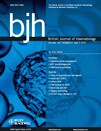Creutzig U, Zimmermann M, Dworzak M, Urban C, Henze G, Kremens B, Lakomek M, Bourquin JP, Starý J, Reinhardt D. Br J Haematol. 2010 May;149(3):399–409. Epub 2010 Mar 8. IF: 4.478

Abstract:
Acute promyelocytic leukaemia (APL) treatment often includes high cumulative doses of anthracyclines, which can cause long-term cardiotoxicity. Here, we report the favourable outcome in 81 paediatric APL patients treated according to the consecutive acute myeloid leukaemia-Berlin/Frankfurt/Muenster (AML-BFM) trials -93/-98/-2004 with an anthracycline-cytarabine regimen in combination with all-trans-retinoid acid (ATRA). Outcomes achieved by treatment with a reduced cumulative anthracycline dose (350 mg/m2) were comparable to those reported for studies with higher doses.
Five-year overall survival of the total cohort was 89 +/– 4 % and event-free survival (pEFS) was 73 +/– 6 %. Overall survival was similar when comparing AML-BFM trial periods (trial 93: 88 +/– 8 %, 98: 85 +/– 7 % and 2004: 94 +/– 8 %, P((logrank)) = 0.63). Seventy-five (93 %) patients achieved complete remission. Most fatal events occurred during the first 6 weeks of treatment. Long-term cardiotoxicity was observed in one patient. Two patients suffered from secondary haematological malignancies. Salvage treatment was effective in 7/9 patients (78 %) with relapsed APL, who now are long-term survivors after second line combination treatment with arsenic trioxide (4/7 patients) and stem cell transplantation (5/7 patients).
Our results demonstrate that – combined with ATRA – a lower cumulative anthracycline dose can be used safely to maintain high cure rates and promote the reduction of long-term sequelae, such as cardiotoxicity in APL patients.
-az-